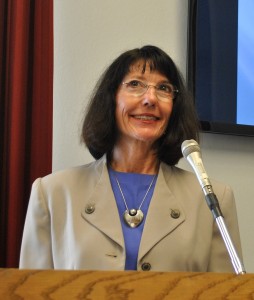On Tuesday, May 5th, a Congressional briefing organized by the Food and Agriculture Policy Collaborative (FAPC)* highlighted federal programs to support local and regional food and farming, economic development, improved health outcomes, and access to good food. The briefing was part of a successful and growing partnership of FAPC members, linking federal policy with place-based outcomes and efforts. The “Healthy Farms, Food, Families, and Economies” briefing, sponsored by Representatives Jeff Fortenberry (R-NE-1) and Marcia Fudge (D-OH-9), brought together voices from the medical, rural development, family farming, and farm to school communities, as speakers shared firsthand experiences with federal programs leading to local successes.
The speakers were:
- Diana B. Cutts, Pediatrician, Hennepin County Medical Center and Principal Investigator, Children’s HealthWatch, Minneapolis, MN
- Jess Piskor, Co-Owner Bare Knuckle Farm, Northport, MI
- Vanessa Hayes, Food Service Director, Tift County Schools, Tifton, GA
- Deirdre Birmingham, Co-Owner, The Cider Farm, Mineral Point, WI
- David Procter, Director, Rural Grocery Initiative at Kansas State University, Manhattan, KS
The panel shared about the importance of the Farm to School Grant Program (F2S), Value Added Producer Grant Program (VAPG), Supplemental Nutrition Assistance Program (SNAP), the Food Insecurity Nutrition Incentive Program (FINI), and the Healthy Food Financing Initiative (HFFI) to their communities. The Congressional staffers in attendance learned about how these federal programs were building foundations for healthier diets among both children and adults, fighting food insecurity and hunger, creating quality employment and marketing opportunities for food and farm businesses, and helping small towns and rural America to thrive.
The multiple benefits of these federal programs to diet and health, employment and economic development were featured prominently in all of the panelists’ speeches. Though speaking about different programs, the panelists demonstrated how federal programs greatly enhanced their shared efforts to serve vulnerable populations, and validated the shared view of FAPC partners that health and place are inextricably linked.
Dr. Cutts and Mr. Piskor drew attention to the problems of food insecurity in low-income communities in Minnesota and Michigan, and how SNAP and SNAP incentive programs like FINI have helped children and families in need. As a diversified vegetable farmer, Mr. Piskor shared how SNAP incentive programs help families use their SNAP benefits for healthy food purchases at farmers markets through increased purchasing power – helping them to develop healthier eating habits and helping his farm business remain viable.

Ms. Hayes, who, in addition to serving as Food Service Director is a trained chef, shared how the Farm to School Grant Program was making similar positive impacts on healthy eating habits among children and on incomes for farmers.
In her remarks, Ms. Hayes noted,
Our children consume [healthy food] when they taste it, but they have to be exposed to it. And they have to be introduced to it more than once . . . The [Farm to School Grant] funding allows us to spend money on our children and helps them connect what we are trying to show them in the classrooms and cafeterias.
She further went on to describe how local procurement, which is one of several Farm to School activities Ms. Hayes is involved with, can make a difference for farmers seeking markets for their products and ways to increase their incomes.
As a school system that spends more that $300,000 dollars a year on fresh fruits and vegetables, if I could just give 10 or 20 percent to my local farmer, what does that do for his business?

For Ms. Birmingham, a full-time farmer growing cider apples organically, who spoke of the needs for new farmers and of new farmers, federal programs such as the VAPG program have made all the difference. As a program that supports “innovation in food and farming that grows rural economies,” VAPG allowed Ms. Birmingham to see beyond growing a raw product and understand how to proceed in her business planning. She now regularly sells out of her apple cider and brandy products and has helped provide local jobs in her community through her value-added food and farm business.
The theme of viability and economic opportunity was echoed by Dr. Procter, who emphasized how, as anchor businesses, grocery stores are crucial to the survival of small towns and why programs like HFFI are important to help these stores overcome challenges that can hurt sales and even lead to shuttering. Dr. Procter told of the domino effect such closures have on communities in rural America – leading to economic losses for other businesses and leading to lack of healthy food retail options – contributing to food insecurity and high obesity rates.
During the Q&A session that closed out the briefing, Congressional staff sought more information about the access for small and diversified farms to credit and crop insurance, the transition process for the adoption of Farm to School programming at schools, how to address food deserts through food delivery systems, ways that federal grant processes could be improved for farmers, and what federal legislation the speakers were prioritizing.
Currently, the Farm to School Act of 2015, a bill to improve the Farm to School Grant program, is active, awaiting further action by legislators in both the House and Senate as they begin consideration of the Child Nutrition Act Reauthorization (CNR). Both the National Sustainable Agriculture Coalition and the National Farm to School Network have been jointly working to promote the bill as the clock ticks down on the previous CNR from 2010, which is set to expire on Sept. 30th of this year.
The Farm to School Act of 2015
The bipartisan Farm to School Act of 2015 proposes an increase in annual mandatory funding for the successful USDA Farm to School grant program from $5 million to $15 million and full inclusion of preschools, summer food service sites, after school programs, and tribal schools and producers. Currently, the program is only able to fund 1 out of every 5 applications. The proposed legislation also aims to improve program participation from beginning, veteran and socially disadvantaged farmers and ranchers. Since its launch in 2011, the USDA Farm to School Grant Program has supported over 200 projects that benefit farmers, kids and communities nationwide.
The bicameral bill was introduced on February 25, 2015 by Senators Thad Cochran (R-MS) and Patrick Leahy (D-VT) and and Representatives Jeff Fortenberry (R-NE) and Marcia Fudge (D-OH). Congress will consider the Farm to School Act as part of the reauthorization of the Child Nutrition Act.
TAKE ACTION!
- Sign our individual cosponsor letter – join us and our bipartisan champions in telling Congress: farm to school is a powerful tool for supporting our kids, our farmers and our communities!
- Add your organization to our growing list of supporters.
- Sign up for action alerts (using the sidebar on left) to stay up-to-date on the latest to support the Farm to School Act of 2015.
- Learn more about the Farm to School Act of 2015.
- See our press release on the introduction of the Farm to School Act of 2015.
- See press releases from Senator Cochran, Senator Leahy, Representative Fortenberry, and Representative Fudge.
- See this joint NFSN-NSAC blog on a recent Congressional briefing and Hill visits by Farm to School advocates from around the country in support of the Farm to School Act of 2015.
*FAPC is a partnership of national and local organizations working to promote the vision of healthy food and healthy economies through the advancement of four policy priorities: 1) Protect and improve the structure, eligibility rules and benefit levels in the Supplemental Nutrition Assistance Program (SNAP); 2) Increase fruit and vegetable incentive programs for SNAP participants; 3) Build and improve existing healthy food stores and supply chains through Healthy Food Financing Initiatives (HFFI); and 4) Strengthen marketing opportunities and the supply chain infrastructure that connects local farmers and ranchers with consumers. National FAPC partners amplifying shared successes are the National Sustainable Agriculture Coalition, Fair Food Network, Food Research and Action Center, and PolicyLink. Local Partnerships include: D.C. Hunger Solutions, The Food Trust, Metropolitan Organizing Strategy, The Reinvestment Fund, and Southeastern African-American Farmers Organic Network.

